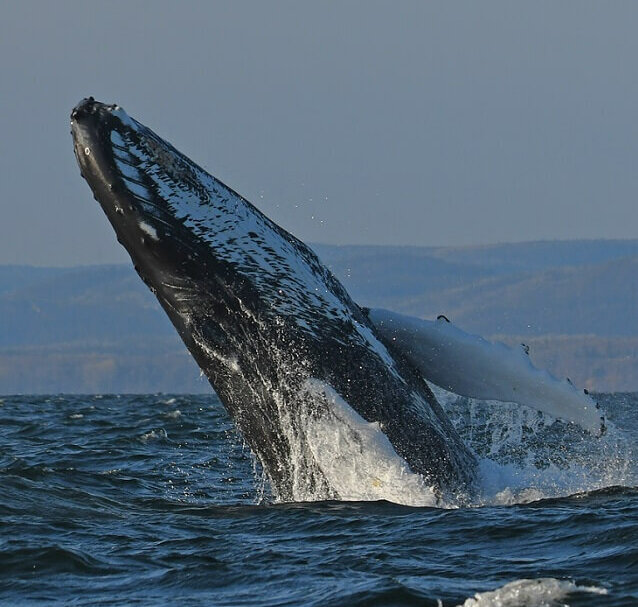Tic Tac Toe, an easily recognizable female humpback whale with a large “X” on her caudal fin, was seen several times with a calf by her side during the 2022 summer season. This mother-calf duo intrigued the whale-watching community, since this would mean that the little one would be Tic Tac Toe’s third calf in barely three years!
Normally, female humpbacks give birth at intervals of two to three years. Nevertheless, giving birth to a calf every year is not impossible for this species. Even if it is very energy-intensive for the female, this extraordinarily rare phenomenon has been observed a few times in other female humpbacks.
Tic Tac Toe: A feisty whale
Accustomed to the estuary and well known to research groups, Tic Tac Toe was born in 1997 in the Caribbean and was first seen in the St. Lawrence that same year, accompanied by her mother. She returned in 1999, this time alone and old enough to fend for herself.
In 2007, the young female was observed in the estuary with her first calf, Aramis, which made Tic Tac Toe the first humpback whale to escort a calf to the estuary! Tic Tac Toe had a second calf in 2012 and a third in 2017!
In 2020, she had her fourth offspring, in addition to becoming a grandmother: her daughter Aramis gave birth to her first calf the same year! In 2021, Tic Tac Toe was once again observed in the estuary with a calf in tow, and the following summer another youngster was swimming at her side. Now 26, Tic Tac Toe is believed to have had three calves in the span of three years!
Energy challenge
Generally, gestation in the humpbacks lasts 11 to 12 months. Once born, the little one will be nursed for 5 to 10 months and will stay with its mother for a year, sometimes two. Theoretically, a female could therefore have a calf every year. However, this implies that the female will still be nursing her youngest while she is pregnant, a significant challenge in terms of energy.
In the majority of baleen whales, females go without food for the first few months after calving: mainly to be present and protect their young, but also to allow the latter to grow more quickly. Indeed, newborns have significant energy needs, which are met thanks to the high-fat milk provided by their mother during nursing. For these females, nursing while pregnant is quite a challenge, as they must both ensure the well-being of their offspring and meet their own needs, not to mention those of the fetus.
Déjà-vu in the Pacific
One particular humpback whale frequently observed in British Columbia waters has purportedly already had several calves in a short period. The female, nicknamed Big Mama, is believed to have had four calves in six years. Tic Tac Toe, with her three calves in as many years, is not too far behind this female from the Pacific, who is currently with her seventh calf.
An uncertain but nevertheless reassuring observation
It is possible that the calf that accompanied Tic Tac Toe is indeed one of her own. On the other hand, it is still difficult to say with certainty, as there are other species of marine mammals in which mothers sometimes take under their wing (or rather under their fin!) young that are not their own in order to shepherd them through their first months of life. These instances of allocare have been observed in particular in sperm whales and belugas.
It can also happen that a very small individual could be mistaken for a rather burly calf. Also, in the event that a female’s last-born calf dies prematurely, she will be fertile again and available for mating soon thereafter. However, the 2020 and 2021 Tic Tac Toe calves are known to have survived their first year of life, making this explanation less plausible. The two were actually seen and identified during the summer of 2022 in the estuary.
This sudden spike in births likely indicates that the humpback whale population is in good shape. This species has long been considered threatened by the Committee on the Status of Endangered Wildlife in Canada (COSEWIC). In 2003, its status was revised from “special concern” to “not at risk.” An increase in prey availability or a decrease in predation may be the cause, which is excellent news for the species’ survival.
So what can we conclude from all this?
Although a calf was observed swimming near Tic Tac Toe in the summer of 2022, it cannot yet be said for sure that it is hers. Nevertheless, it can be affirmed that the three calves observed at her side are three distinct individuals, having all been seen and identified in the St. Lawrence the same summer.
Only a genetic test and a greater number of observations would make it possible to declare beyond any doubt that Tic Tac Toe has indeed mothered three calves in three years! Will we see her with another calf this summer? We’ll soon find out!








